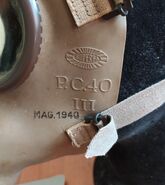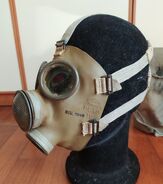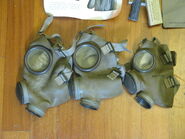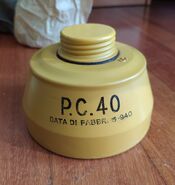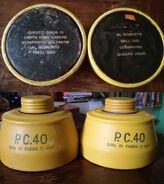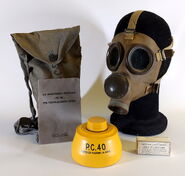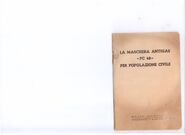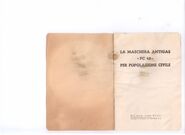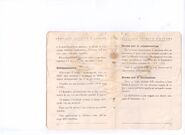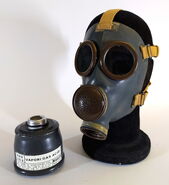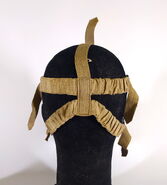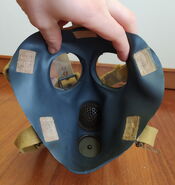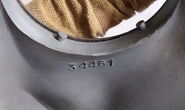The P.C.40 was the last main civilian mask design produced in Italy before the end of the Second World War. Early on in the War, it was sold directly by the State to the population, to those in the risk of a chemical attack. Later, some were issued by the state for free to some corps, and it was used both passively and actively in place of other masks.
After the end of the War, an updated version was produced for industrial purposes. It's unclear whether War-time P.C.40s were used in industries as well, but it's likely (the ads that show P.C.40s being sold for industrial use are in black and white and since early post-War production P.C.40s use the same harness as wartime produced ones, they are impossible to tell apart).
Wartime variant[]
The P.C. 40 design is based on the T.35, with a series of changes to make it cheaper to produce.
Mask overview[]
The faceblank, made of a thin foil of moulded rubber; it has the following parts attached to it:
- the housing for the exhale valve
- the inlet assembly
- the eyepieces
- the straps
The inlet valve allows filtered air in from the filter and does not allow exhaled air to go back out from the filter again. Said rubber valve is housed in the metal threaded assembly, used to screw the filter in.
The exhale valve allows exhaled air to go outside and prevents poisoned air to get in. It's made of rubber, it opens under the light pressure of exhaling and closes hermetically under the negative pressure produced by the inhalation. It can be easily inspected and possibly replaced by unscrewing the lid of its housing, made with aluminium to be cheaper.
The eyepieces are made of cellulose acetate instead of the previously used "Triplex" glass. The glasses are affixed to the mask through aluminium frames. Size 4 masks use smaller lenses and frames to better fit the wearer.
Anti-fogging lenses could be applied using the rubber studs around the inside of the eyepieces (save for size 4 masks, which had smaller lenses). Anti-fogging lenses were not issued with this mask normally.
The elastic harness, based on the T.35, has the goal to keep the mask tightly onto the face. It is composed of 5 adjustable straps (a top one, two elastic temple ones and two elastic cheek ones) attached to the facepiece, and they gather into a nape pad, which is much smaller than its predecessor's.
The quality of the parts and the rubber decreased during the war due to dwindling stocks of quality metal and natural rubber. In some cases, the colour of the paint was changed, due to unknown reasons.
Filter[]
The filter had the same shape as the Pirec38 filter but was painted yellow. It featured a paper disc on the inlet that was to be removed when the mask was to be used.
Kit[]
The mask came in two different kits: most masks were stored in a cardboard box and came with the filter, a stick of anti-fogging soap and the manual. Some masks had a dedicated cheaper variation of the T.35 bag and had the same accessories.
Box kit[]
Pirelli size 2 sample
Bag kit[]
Superga size 3 and 4 samples
Extra gallery[]
Pirelli manual for the P.C. 40[]
Post-war variants[]
During the '50s, Pirelli decided to reintroduce the P.C. 40 with industrial use in mind. The idea behind it was to offer a lighter and more comfortable variant of the Post-War Pirelli T.35 masks to be used for prolongued and burdensome jobs. The quality of the rubber and furniture was improved over the wartime production, and the lenses used were made of triplex glass instead of cellulose.
It's possible that this masks were at some point offered for civilians or civil protection, but there is no confirmation of that.
Variants[]
There were two main distinguished variants:
- An earlier variant with a wartime-style set of straps
- A later variant with a T.35-style harness
The earliest variants are usually made of gray rubber, with blue valves, and an inlet piece with a single stud, with later production progressively the rubber blend became more blue, the valves would be made with beige rubber and the inlet piece used would become one with two studs in a cross instead of a single stud.
Kit[]
The mask could be purchased with a small filter directly attached to the mask, a larger filter held by a cage carrier, or with a fresh-air breathing apparatus set. A bag and anti-fogging lenses could be purchased with the set too.





